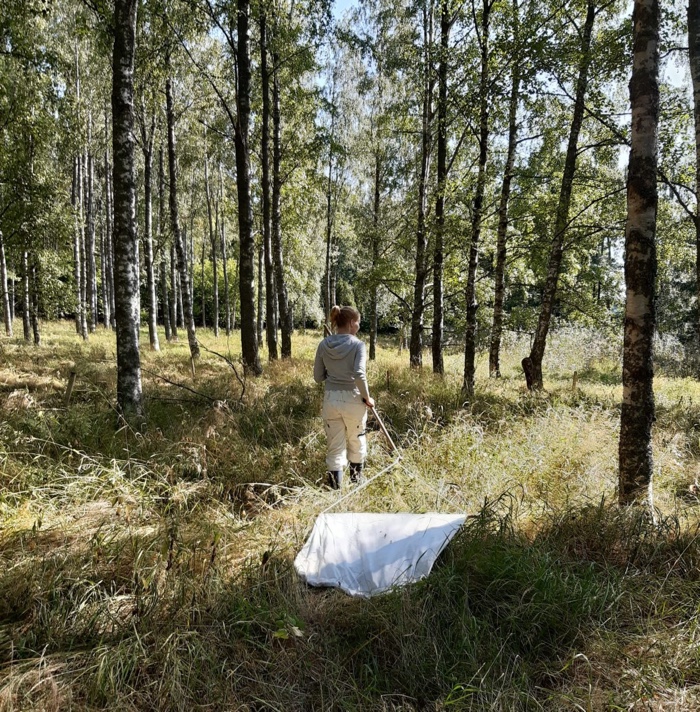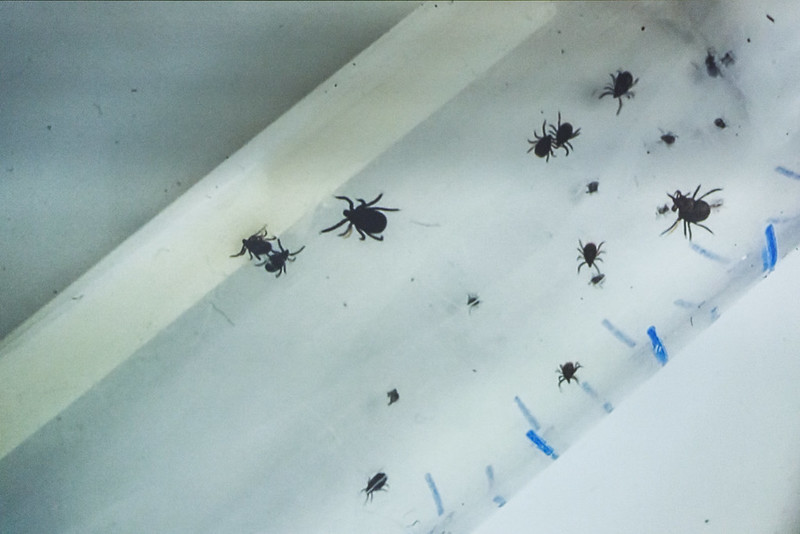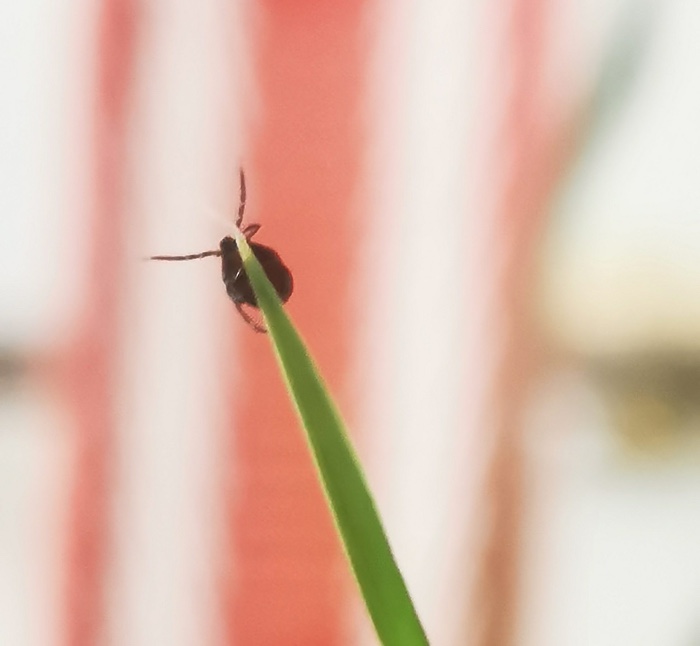The second talk* that particularly impressed me during the Meta.Morf 2022 – Ecophilia conference organised by TEKS in Trondheim a few weeks ago, was Laura Beloff‘s The Dark Side of Evolution; On Ticks.
While the whole festival explored the ambiguities of society’s self-proclaimed love for nature, Beloff‘s contribution probed into ecophobia and more specifically the rejection and disgust we feel towards creatures like ticks and other parasites.

Laura Beloff at the Meta.Morf 2022 – Ecophilia conference. Photo: Juliane Schütz / Meta.Morf 2022

Laura Beloff, Tick Terrarium, 2020 (TICK ACTs), SOLU Space, May 2021. Photo: Mari Kaakkola
Beloff, an artist and researcher from Aalto University, reminded us that while the contemporary discourse on the environmental crisis urges us to reassess our worldview and embrace all non-human lives, from bacteria to wolves, fungi to oaks, most of us feel uncomfortable or even hostile towards ticks.
Beloff opened her presentation with an extract from Jakob von Uexküll‘s study of the tick in his 1934’s publication A Stroll Through the Worlds of Animals and Men; A Picture book of Invisible Worlds:
The eyeless tick is directed to this watchtower by a general photosensitivity of her skin. The approaching prey is revealed to the blind and deaf highway woman by her sense of smell. The odor of butyric acid, that emanates from the skin glands of all mammals, acts on the tick as a signal to leave her watchtower and hurl herself downwards. If, in so doing, she lands on something warm — a fine sense of temperature betrays this to her — she has reached her prey, the warm-blooded creature. It only remains for her to find a hairless spot. There she burrows deep into the skin of her prey, and slowly pumps herself full of warm blood.

Laura Beloff at the Meta.Morf 2022 – Ecophilia conference. Photo: Juliane Schütz / Meta.Morf 2022
Studies have shown an increase in tick populations and in the diseases they cause globally.
The blood-sucking arachnids carry many pathogens but only some of them are harmful for the mammals they attach to. The main ones are:
– the bacteria borrelia burgdorferi, the cause of the Lyme disease,
– a virus responsible for tick fever or Encephalitis,
– and Alpha-gal, a sugar molecule that can cause you to become allergic to red meat.
Ticks lead a rather stationary life: they climb up the grass and then just wait. And wait. And wait for a host. Some hosts might take the tick far away, others will just walk them around the vicinity. Some can migrate very far away using birds.

Tick collecting, 2019. Photo: Kira O’Reilly

Laura Beloff at the Meta.Morf 2022 – Ecophilia conference. Photo: Juliane Schütz / Meta.Morf 2022
How do ticks eat?
A tick has 3 phases in its life: larvae, nymph and adult. It needs 3 blood meals to move from one phase to the next one.
Ticks are parasites. They benefit from the host but, unlike other predators, they have a continuous intimacy with the host. Ticks usually elicit disgust in humans. They perceive them as intruders, as stray animals without right to a home in our landscape. In his 1980‘s book The Parasite, Michel Serres applies Claude Shannon’s information theory to parasites and, from there, he proposes that the parasite is key to evolution and to our relation with the surrounding world. The philosopher compares noise to parasitism by proposing that “noise gives rise to a new system, an order that is more complex than the simple chain. The parasite interrupts it, is vaccinated, becomes immune.”
Serres also follows biophysicist Henri Atlan in arguing that noise prompts a system to reorganise in a more complex form that incorporates the disturbance. Noise, or in this case a parasite, pushes you to reorganise the whole system.
“In each case, the parasite interferes in, and ultimately upsets, some existing set of relations and pattern of movement,” writes Serres. “It compels us either to expel it, or to readjust our internal workings so that we can accommodate the needs of the parasite. Noise, in other words, is to communication what a virus is to an organism, or a scapegoat is to a community. It is not simply an obstacle, but rather a productive force around the exclusion of which the system is organized. Noise, in other words, is to communication what a virus is to an organism, or a scapegoat to a community. It is not simply an obstacle, but rather a productive force around the exclusion of which the system is organised.”
Serres sees the parasite as a key to evolution. A similar understanding is also advocated by evolutionary biologists such as Tuomas Aivelo whose research focuses on parasites and pests. In a recent book that looked at parasites in prehistory, Aivelo wrote that “whilst there was plenty of plant-based food in Africa thought the year, in the harsher conditions in Europe, Neanderthals hunted meat on which to live during the Winter. Meat predisposes more to parasites and therefore Neanderthals probably had a more effective immune defence system than our own ancestors. When moving to the Neanderthalian habitat and consuming the same diet, modern humans also inherited the Neanderthal’s parasites. Neanderthals have long been extinct but their gene pool helped modern humans adapt to the new environment in the most intimate ways. We have inherited from Neanderthals not only their parasites but also their immune genes. These genes were beneficial to modern humans as they spread around the world. However, now there are no longer so many parasites in our environment, they have become harmful.” With these words, Aivelo suggests that humans would not have evolved to what they are today were it not for parasites.
Beloff concluded that we can think of parasites as noise in the system that challenges and potentially reorganises our minds and bodies as well as forces us to cope with old and new relations and the unexpected noise in them.

First prototype of a wearable glass terrarium for ticks. Conceived and fabricated by Laura Beloff for a collaborative project by Laura Beloff and Kira O’Reilly, 2019

Laura Beloff, Tick Terrarium, 2020
Her artistic investigations into the world of ticks and our relation to them started as a collaboration with Kira O’Reilly in 2019. Together, they did some research, met with scientists in diverse universities, recorded Tick Talk podcasts and produced artworks. Beloff’s The Tick Garden and The Tick Terrarium are two of them.
The Tick Terrarium is a wearable glass habitat for ticks. It plays with our love of nature, our fear of glass and the disgust that ticks generate. It looks like a suicide bomber vest, in a reference to a U.S. bioweapon research from 1950s to 70s. In a book called Bitten. The Secret History of Lyme Disease and Biological Weapons, science writer Kris Newby suggested that the Pentagon carried out experiments to spread diseases using ticks and insects as bioweapons.

Photo: Laura Beloff
Beloff also made a Tick Garden to observe ticks in her own apartment, just like you would observe animals in zoos or plants inside terrariums. Made of glass, the cylinder contains soil, dead leaves, grass and of course ticks in different sizes and stages of their life. The garden investigates the habitat and survival of ticks but it also speculates on the concepts of domesticated and wilderness. The distinction between the wild and the domesticated stems from an ideological commitment to human mastery. Because of this desire to control, domesticated species are condemned to life imprisonment and genetic standardisation. Wild species, on the other hand, see their habitats being destroyed and their genetic material preserved in sterile gene banks.
In digital and biotechnological art certain types of aesthetics are dominating and they could be described often as aiming for perfection, Beloff explained. It seems that the mainstream technological mediation and development favours the perfect version of the world, editing the bad, the ugly and the unpleasant such as parasites. One can ask, what are the criteria of our choices when we are modifying organisms or when we decide which non-humans are accepted and which are not? Parasites like ticks would presumably belong to the latter group.

TICK ACTs. Photo: Laura Beloff

TICK TALKs: Multiple Microbe Phenomena, with Leona Gilbert from Tezted
The tick research has been partly conducted in collaboration with Kira O’Reilly under the title TickAct. The podcasts, TickTalks, were produced in collaboration with Kira O’Reilly and commissioned by Bioart Society as a part of their project Biofriction.
This talk is based on two recently written papers:
Beloff L. (2022) Investigating Stray-Concept and Ticks as a Co-Species (forthcoming).
Beloff L. & Søndergaard M. (2022) Living Biotechnological Lives: Noise, Parasites, and Relational Practices (forthcoming).
The Meta.Morf 2022 – Ecophilia conference was curated by Zane Cerpina and organised by TEKS in Trondheim, Norway. The festival continues until 14 August throughout the city.
* The other being Tiny Mining. Extracting minerals from our own body by Martin Howse.


![7 art and tech ideas I discovered at Meta.Morf 2024 – [up]Loaded Bodies 7 art and tech ideas I discovered at Meta.Morf 2024 – [up]Loaded Bodies](https://we-make-money-not-art.com/wp-content/uploads/2024/05/53705969154_73dfdfea6f_c-300x200.jpeg)




